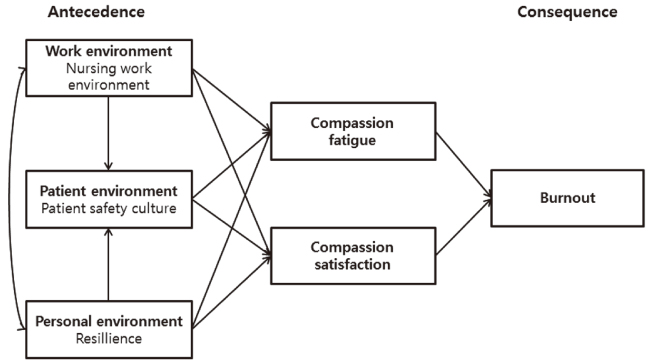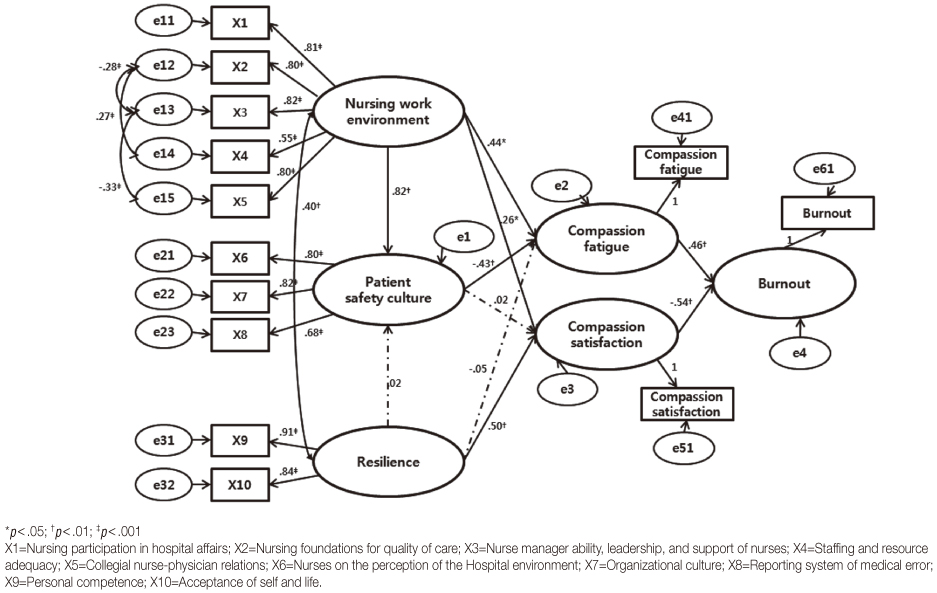J Korean Acad Nurs.
2014 Jun;44(3):259-269. 10.4040/jkan.2014.44.3.259.
Structural Equation Modeling on Burnout in Clinical Nurses based on CS-CF Model
- Affiliations
-
- 1Department of Nursing, Daewon University College, Jechon, Graduate School, Chung-Ang University, Seoul, Korea.
- 2Red Cross College of Nursing, Chung-Ang University, Seoul, Korea. yhyom@cau.ac.kr
- KMID: 1796151
- DOI: http://doi.org/10.4040/jkan.2014.44.3.259
Abstract
- PURPOSE
The purpose of this study was to construct and test a structural equation modeling on burnout of clinical nurses based on CS-CF model.
METHODS
A survey using a structured questionnaire was conducted with 557 clinical nurses. Data were analyzed using structural equation modeling.
RESULTS
The modified hypothetical model yielded the following chi2=289.70, p<.001, RMSEA=.09, GFI=.93, TLI=.91, CFI=.94, PCFI=.65, AIC=363.21, SRMR=.05 or less and showed good fit indices. Nursing work environment, patient safety culture and resilience showed indirect effects on burnout while compassion fatigue and compassion satisfaction had direct effects.
CONCLUSION
Results of this study suggest that compassion fatigue must be decreased and compassion satisfaction has to be increased, while burnout is lowered by enhancing the clinical nursing work environment, patient safety culture and resilience. In addition, more variables and longitudinal studies are necessary to validate the clear cause-and-effect relationship between the relevant variables.
Keyword
MeSH Terms
Figure
Reference
-
1. Park HS, Kim KN. Factors affecting burnout in ICU nurses. J Korean Acad Fundam Nurs. 2010; 17(3):409–418.2. Yu M. Work stress, turnover intention and burnout among nurses in neonatal intensive care units. J Korean Acad Nurs Adm. 2011; 17(1):115–126. http://dx.doi.org/10.11111/jkana.2011.17.1.115.3. Garrett C. The effect of nurse staffing patterns on medical errors and nurse burnout. AORN J. 2008; 87(6):1191–1204. http://dx.doi.org/10.1016/j.aorn.2008.01.022.4. James RK, Gilliland BE. Crisis intervention strategies. 4th ed. Belmont, CA: Brooks/Cole Thomson Learning;2001.5. Joinson C. Coping with compassion fatigue. Nursing. 1992; 22(4):116.6. Figley CR. Compassion fatigue: Coping with secondary traumatic stress disorder in those who treat the traumatized. New York, NY: Brunner-Routledge;1995.7. Figley CR. Treating compassion fatigue. New York, NY: Brunner-Routledge;2002.8. Stamm BH. Measuring compassion satisfaction as well as fatigue: Developmental history of the compassion fatigue and satisfaction test. In : Figley CR, editor. Treating compassion fatigue. New York, NY: Brunner-Routledge;2002. p. 107–119.9. Spence Laschinger HK, Leiter MP. The impact of nursing work environments on patient safety outcomes: The mediating role of burnout/engagement. J Nurs Adm. 2006; 36(5):259–267.10. Vahey DC, Aiken LH, Sloane DM, Clarke SP, Vargas D. Nurse burnout and patient satisfaction. Med Care. 2004; 42:2 Suppl. II57–II66. http://dx.doi.org/10.1097/01.mlr.0000109126.50398.5a.11. Kim JE, Kang MA, An KE, Sung YH. A survey of nurses' perception of patient safety related to hospital culture and reports of medical errors. Clin Nurs Res. 2007; 13(3):169–179.12. Aiken LH, Clarke SP, Sloane DM, Sochalski J, Silber JH. Hospital nurse staffing and patient mortality, nurse burnout, and job dissatisfaction. JAMA. 2002; 288(16):1987–1993.13. June KJ, Byun SW. Nurse' burnout research throughout the past 10 years in Korea. J Korean Acad Nurs Adm. 2009; 15(3):305–313.14. Stam BH. The concise ProQOL manual. 2nd ed. Pocatello, ID: ProQOL.org;2010.15. Van Bogaert P, Meulemans H, Clarke S, Vermeyen K, Van de Heyning P. Hospital nurse practice environment, burnout, job outcomes and quality of care: Test of a structural equation model. J Adv Nurs. 2009; 65(10):2175–2185.16. Pietrantoni L, Prati G. Resilience among first responders. Afr Health Sci. 2008; 8:Suppl 1. S14–S20.17. Huggard PK. Managing compassion fatigue: Implications for medical education [dissertation]. Auckland, NZ: The University of Auckland;2008.18. Yom YH, Kim HJ. Effects of compassion satisfaction and social support in the relationship between compassion fatigue and burnout in hospital nurses. J Korean Acad Nurs. 2012; 42(6):870–878. http://dx.doi.org/10.4040/jkan.2012.42.6.870.19. Park HH. A structural model of nurses' patient safety management activities [dissertation]. Daejeon: Eulji University;2013.20. Burtson PL, Stichler JF. Nursing work environment and nurse caring: Relationship among motivational factors. J Adv Nurs. 2010; 66(8):1819–1831. http://dx.doi.org/10.1111/j.1365-2648.2010.05336.x.21. Lake ET. Development of the practice environment scale of the nursing work index. Res Nurs Health. 2002; 25(3):176–188. http://dx.doi.org/10.1002/nur.10032.22. Cho E, Choi M, Kim EY, Yoo IY, Lee NJ. Construct validity and reliability of the Korean version of the practice environment scale of nursing work index for Korean nurses. J Korean Acad Nurs. 2011; 41(3):325–332. http://dx.doi.org/10.4040/jkan.2011.41.3.325.23. Wagnild GM, Young HM. Development and psychometric evaluation of the Resilience scale. J Nurs Meas. 1993; 1(2):165–178.24. Friese CR, Lake ET, Aiken LH, Silber JH, Sochalski J. Hospital nurse practice environments and outcomes for surgical oncology patients. Health Serv Res. 2008; 43(4):1145–1163. http://dx.doi.org/10.1111/j.1475-6773.2007.00825.x.25. Kanai-Pak M, Aiken LH, Sloane DM, Poghosyan L. Poor work environments and nurse inexperience are associated with burnout, job dissatisfaction and quality deficits in Japanese hospitals. J Clin Nurs. 2008; 17(24):3324–3329. http://dx.doi.org/10.1111/j.1365-2702.2008.02639.x.26. Kim HY, Kim HS. Effects of perceived patient safety culture on safety nursing activities in the general hospital nurse's. J Korean Acad Nurs Adm. 2011; 17(4):413–422. http://dx.doi.org/10.11111/jkana.2011.17.4.413.27. Jang YM. Coping strategies, compassion fatigue and compassion satisfaction among nurses in emergency room [master's thesis]. Daejeon: Eulji University;2014.28. Lee GS, Yom YH. Structural equation modeling on life-world integration in people with severe burns. Asian Nurs Res. 2013; 7(3):112–119.29. Epp K. Burnout in critical care nurses: A literature review. Dynamics. 2012; 23(4):25–31.
- Full Text Links
- Actions
-
Cited
- CITED
-
- Close
- Share
- Similar articles
-
- A Structural Model for Burnout and Work Engagement of Nurses in Long-term Care Hospitals: Application of the Expanded Job Demand-Job Resources Model
- A structural equation model of organizational commitment by hospital nurses: The moderating effect of each generation through multi-group analysis
- Model Setting and Interpretation of Results in Research Using Structural Equation Modeling: A Checklist with Guiding Questions for Reporting
- Structural Equation Modeling for Humor, Job Satisfaction, Job Stress and Intention to Turnover
- Structural Equation Modeling of Nurses’ Experience of Workplace Incivility



